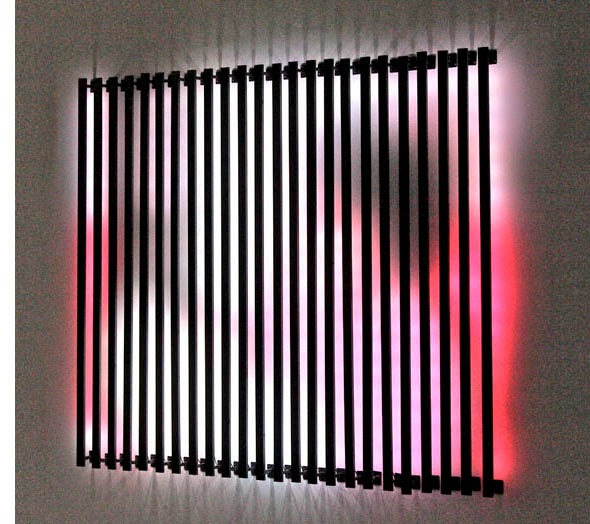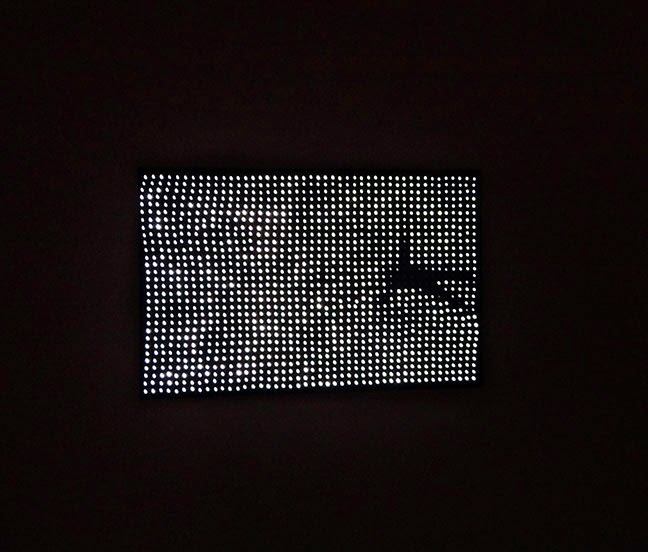A NEW KIND OF LIGHT
a review of Jim Campbell's forays into light
By Casey Everett
 |
| Boo! |
Walking into The Hosefelt gallery I was immediately disoriented by the lack of light. The gallery felt completely different from its usual blank, white wall aesthetic and then I remembered that I had entered a Jim Campbell show. For Campbell, light is both the method and madness of a highly unusual artistic practice. The Interactive video sculptural installations that Campbell creates seem a repository of odd memories, off-hand experiences and a model for the way in which our brains collect and interpret information. His work is a critique of the way modern technologies distance us from experience and feeling and yet Campbell uses that same technology to force us to see how we are connected—to our memories, to other people and, most disturbingly, how we process information, especially visual information. This combination of film, light and sculpture is truly disorientating.
In two pieces, a part of a series titled, “Home Movies,” Campbell takes small LED lights and turns them away from the viewer so that the light falls away from us. Each LED represents one pixel of the whole image. They are videos of various iconic occasions: birthday parties, vacations, holidays and other significant life events. They capture intimate and important moments in life and even though they aren’t our memories they feel like it. Campbell achieves this by obscuring faces and blurring the film just enough to make it seem like everyone’s celebration and by doing so he makes these found images seem more like a collective dream. It’s a stunning effect and makes us feel as if our lives are emerging from his art, that his art has captured our memories.
 |
| Get out of jail |
In another piece from his “Home Movies” series, twenty-four black bars extend out from the wall creating what looks like the jail bars of a jail cell. Behind each bar is a bright neon light projected on the wall behind it. Stepping back from the work you can decode the images, even though the black bars are blocking half the figures. Here, Campbell shows us how we put together fragments of visual information, how we always have to have both the correct angle and the necessary distance. The video starts and stops almost randomly and that makes you feel as if anything can be lost, even your memories. In this, the jail imagery works in two ways: one, we’re both confined by the past, but two, we’re always escaping from it as well. In Campbell’s work, what we see seems obvious and at the same time so difficult to fully grasp. It’s a crazy balance and he works it to perfection.
In the more recent pieces of the “Home Movies” series, Campbell uses more color than his previous installations. Here he tries to add another dimension and layer to how we perceive the world. The projected images are blurry, but the subjects still retain their recognizable form. Campbell forces us to recognize that we are always projecting, replacing and substituting our own experiences with what we see. By slightly blurring the images, we see much more clearly what we do naturally. This is quite disorienting and when you see these new pieces you feel off kilter and caught in an act of visual theft.
 |
| The past is blurry |
Other works in the exhibition include a piece titled, “Light Tophography (Jane’s pool),” which uses three-dimensional sculptural forms to catch various aspects of a low-resolution video of ocean waves crashing. The varying heights of the sculptures, essentially acting as twisted movie screens, fragment what we normally see as a unified and natural experience. It’s as if space and time are starting to break up right in front of us. It’s electrifying and not pleasant at the same time.
Campbell’s awareness of how we perceive the world and his manipulation of it is exciting and fascinating. We rarely get to experience what it’s like to live in another person’s life. It turns out that it’s very close to our own, which is all the more upsetting, strange and disorienting. This show is a clear demonstration of his understanding and mastery of film, sculpture and the human psyche—an amazing show.
 |
| What happened? |
©Casey Everett and the CCA Arts Review

No comments:
Post a Comment